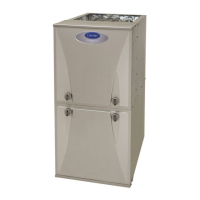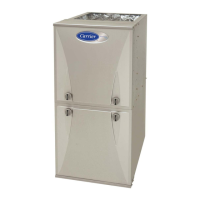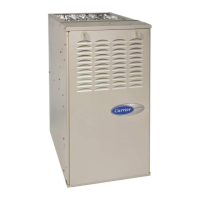PG92MSA: Installation, Start-up, Operating and Service and Maintenance Instructions
Manufacturer reserves the right to change, at any time, specifications and designs without notice and without obligations.
65
NOTE: After cleaning, inspect the heat exchangers to ensure they are
free of all foreign objects that may restrict flow of combustion products.
8. Reverse items 6 through 1 for reassembly.
9. Refer to furnace wiring diagram and reconnect wires to flame
rollout switch, gas valve, igniter, and flame sensor.
10. Turn on gas and electrical supplies to furnace.
11. Check furnace operation through 2 complete heat operating cycles.
Look at burners. Burner flames should be clear blue, almost
transparent. See Fig. 66.
12. Check for gas leaks.
13. Replace main furnace door.
Secondary Heat Exchangers
The condensing side (inside) of the secondary heat exchanger CANNOT
be serviced or inspected without complete removal of the heat exchanger
assembly. Detailed information on heat exchanger removal can be
obtained from your Distributor.
WINTERIZATION
Since the furnace uses a condensing heat exchanger, some water will
accumulate in the unit as a result of the heat transfer process. Therefore,
once it has been operated, it cannot be turned off and left off for an
extended period of time when temperatures will reach 32_F (0_C) or
lower unless winterized. Follow these procedures to winterize your
furnace:
1. Obtain propylene glycol (RV/swimming pool antifreeze or
equivalent).
2. Turn off gas and electrical supplies to your furnace.
3. Remove furnace control door.
4. Remove the top unused rubber plug from the port on the collector
box opposite the condensate trap. See Fig. 63.
5. Connect a field supplied 3/8-in. (9.5-mm) ID tube to the open port
on the collector box.
6. Insert a field supplied funnel into the tube.
7. Pour one quart (liter) of anti-freeze solution into the funnel/tube.
Antifreeze should run through the inducer housing, overfill
condensate trap and flow to an open drain.
8. Replace the rubber plug in the port on the collector box.
9. Remove the middle unused rubber plug from the port on the
collector box opposite the condensate trap. See Fig. 63.
10. Repeat Steps 5 through 8.
11. If a condensate pump is used, check with pump manufacturer to
verify pump is safe for use with antifreeze used. Allow pump to
start and pump anti-freeze to open drain.
12. Replace main door.
13. When furnace is re-started, flush condensate pump with clear water
to check for proper operation before re-starting furnace.
14. Propylene glycol need not be removed before re-starting furnace.
SEQUENCE OF OPERATION
NOTE: Furnace control must be grounded for proper operation or
control will lock out. Control is grounded through green/yellow wire
routed to gas valve and manifold bracket screw. Using the schematic
diagram in Fig. 62, follow the sequence of operation through the
different modes. Read and follow the wiring diagram very carefully.
NOTE: If a power interruption occurs during a call for heat (W), the
control will start a 90-sec blower-only ON period two sec after power is
restored, if the thermostat is still calling for gas heating. The LED light
will flash code 12 and display will show (12.1) during the 90-sec period,
after which the LED will be ON continuous, as long as no faults are
detected. After the 90-sec period, the furnace will respond to the
thermostat normally.
The blower door must be installed for power to be conducted through the
blower door interlock switch ILK to the furnace control CPU,
transformer TRAN, inducer motor IDM, blower motor BLWM,
hot-surface igniter HSI, and gas valve GV.
1. Heating
See Fig. 38 and Fig. 39 for thermostat connections.
The wall thermostat “calls for heat,” closing the R-to-W circuit.
The furnace control performs a self-check, verifies the pressure
switch contacts LPS and HPS are open, and starts the inducer motor
IDM.
a. Inducer Prepurge Period- As the inducer motor IDM comes up
to speed, the collector box pressure switch contacts LPS close, 24
VAC power is supplied for a field installed humidifier at the
HUM terminal and the control begins a 15-sec prepurge period.
The inducer housing pressure switch contacts HPS are ignored
until one minute after the gas valve closes.
b. Igniter Warm-Up- At the end of the prepurge period, the
Hot-Surface Igniter HSI is energized for a 17-sec igniter
warm-up period.
c. Trial-for-Ignition Sequence- When the igniter warm-up period
is completed, the main gas valve relay contacts GVR close to
energize the gas valve GV, the gas valve opens. The gas valve
GV permits gas flow to the burners where it is ignited by the
HSI. Five sec after the GVR closes, a 2-sec flame proving period
begins. The HSI igniter will remain energized until the flame is
sensed or until the 2-sec flame proving period begins.
d. Flame-Proving- When the burner flame is proved at the
flame-proving sensor electrode FSE, the furnace control CPU
begins the blower-ON delay period and continues to hold the gas
valve GV open. If the burner flame is not proved within two sec,
the control CPU will close the gas valve GV, and the control
CPU will repeat the ignition sequence for up to three more
Trials-For-Ignition before going to Ignition-Lockout. Lockout
will be reset automatically after three hours or by momentarily
interrupting 115 vac power to the furnace, or by interrupting 24
vac power at SEC1 or SEC2 to the furnace control CPU (not at
W, G, R, etc.).
If flame is proved when flame should not be present, the furnace
control CPU will lock out of Gas-Heating mode and operate the
inducer motor IDM until flame is no longer proved.
e. Blower-ON Delay- If the burner flame is proven, the blower
motor is turned on at HEAT speed 25 sec after the gas valve GV
is energized.
CAUTION
!
UNIT AND PROPERTY DAMAGE HAZARD
Failure to follow this caution may result in unit component or property
damage.
If the furnace is installed in an unconditioned space where the ambient
temperatures may be 32_ F (0_ C) or lower, freeze protection measures
must be taken to prevent minor property or product damage.
CAUTION
!
UNIT COMPONENT DAMAGE HAZARD
Failure to follow this caution may result in damage to the furnace and
other property damage.
Do not use ethylene glycol (automotive antifreeze coolant or
equivalent). Failure of plastic components may occur.

